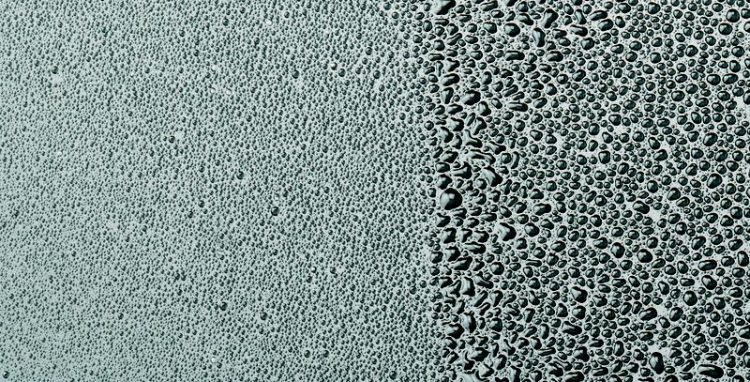Technology transfer: Automated quality assurance of CFRP surfaces becomes industrial reality

Change in droplet size at the boundary between a flame-treated (right) and non flame-treated (left) polypropylene blend. (c) Fraunhofer IFAM
Lightweight aircraft and cars are designed using components made of carbon fiber reinforced plastic (CFRP).
The manufacture of these CFRP components is carried out in metallic molds. Demolding is generally facilitated by treating the molds beforehand with a release agent.
However, some release agent adheres to the molded product and these residues must be removed manually prior to subsequent coating or bonding.
Contamination of CFRP surfaces by release agent residues impairs adhesion and hence the quality of bonded joints. So how can such residues be detected on components?
Automated monitoring of CFRP surfaces
Fraunhofer IFAM scientists have developed an automated aerosol wetting test suitable for industrial production. This wetting test efficiently inspects the surfaces of large components during the production process.
An ultrasonic atomizer first of all generates a defined water aerosol. This then creates a characteristic pattern of droplets on the component surface that is being inspected. A camera system records these droplets and shows them on a screen.
The droplet size distribution allows statements to be made about the wetting properties of the surface. By defining target values, for example, the cleaning and activation effect of a surface pretreatment step can be automatically monitored.
The advantage of the aerosol test is that large surfaces, for example fiber composite components for aircraft and wind turbines, can also be tested. The water aerosol dries within a very short time and leaves no residues, meaning the components can be further processed shortly after inspection.
Media Contact
All latest news from the category: Materials Sciences
Materials management deals with the research, development, manufacturing and processing of raw and industrial materials. Key aspects here are biological and medical issues, which play an increasingly important role in this field.
innovations-report offers in-depth articles related to the development and application of materials and the structure and properties of new materials.
Newest articles

Targeted use of enfortumab vedotin for the treatment of advanced urothelial carcinoma
New study identifies NECTIN4 amplification as a promising biomarker – Under the leadership of PD Dr. Niklas Klümper, Assistant Physician at the Department of Urology at the University Hospital Bonn…

A novel universal light-based technique
…to control valley polarization in bulk materials. An international team of researchers reports in Nature a new method that achieves valley polarization in centrosymmetric bulk materials in a non-material-specific way…

How evolution has optimised the magnetic sensor in birds
The magnetic sense of migratory birds is probably based on the protein cryptochrome 4, and a genetic study has now provided further support for this theory. A team of researchers…





















